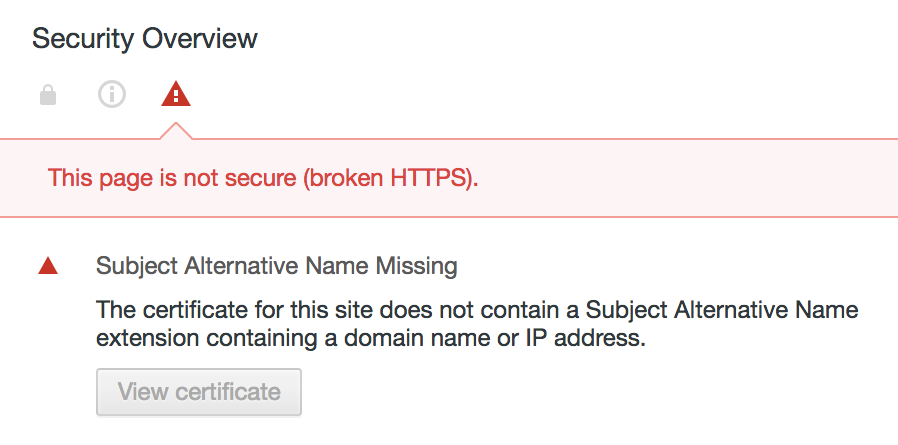
Alexander Zeitler
Fixing Chrome 58+ [missing_subjectAltName] with openssl when using self signed certificates
Since version 58, Chrome requires SSL certificates to use SAN (Subject Alternative Name) instead of the popular Common Name (CN), thus CN support has been removed.
If you're using self signed certificates (but not only!) having only CN defined, you get an error like this when calling a website using the self signed certificate:

Here's how to create a self signed certificate with SAN using openssl
First, lets create a root CA cert using createRootCA.sh:
#!/usr/bin/env bash
mkdir ~/ssl/
openssl genrsa -des3 -out ~/ssl/rootCA.key 2048
openssl req -x509 -new -nodes -key ~/ssl/rootCA.key -sha256 -days 1024 -out ~/ssl/rootCA.pemNext, create a file createselfsignedcertificate.sh:
#!/usr/bin/env bash
sudo openssl req -new -sha256 -nodes -out server.csr -newkey rsa:2048 -keyout server.key -config <( cat server.csr.cnf )
sudo openssl x509 -req -in server.csr -CA ~/ssl/rootCA.pem -CAkey ~/ssl/rootCA.key -CAcreateserial -out server.crt -days 500 -sha256 -extfile v3.extThen, create the openssl configuration file server.csr.cnf referenced in the openssl command above:
[req]
default_bits = 2048
prompt = no
default_md = sha256
distinguished_name = dn
[dn]
C=US
ST=New York
L=Rochester
O=End Point
OU=Testing Domain
emailAddress=your-administrative-address@your-awesome-existing-domain.com
CN = localhostNow we need to create the v3.ext file in order to create a X509 v3 certificate instead of a v1 which is the default when not specifying a extension file:
authorityKeyIdentifier=keyid,issuer
basicConstraints=CA:FALSE
keyUsage = digitalSignature, nonRepudiation, keyEncipherment, dataEncipherment
subjectAltName = @alt_names
[alt_names]
DNS.1 = localhostIn order to create your cert, first run createRootCA.sh which we created first.
Next, run createselfsignedcertificate.sh to create the self signed cert using localhost as the SAN and CN.
After adding the rootCA.pem to the list of your trusted root CAs, you can use the server.key and server.crt in your web server and browse https://localhost using Chrome 58 or later:

You can also verify your certificate to contain the SAN by calling
openssl x509 -text -in server.crt -nooutThis should look like this:
Certificate:
Data:
Version: 3 (0x2)
Serial Number: 17237690484651272016 (0xef38942aa5c52750)
Signature Algorithm: sha256WithRSAEncryption
Issuer: C=US, ST=New York, L=Rochester, O=End Point, CN=localhost/your-administrative-address@your-awesome-existing-domain.com
Validity
Not Before: Apr 23 16:07:38 2017 GMT
Not After : Sep 5 16:07:38 2018 GMT
Subject: C=US, ST=New York, L=Rochester, O=End Point, OU=Testing Domain/emailAddress=your-administrative-address@your-awesome-existing-domain.com, CN=localhost
Subject Public Key Info:
Public Key Algorithm: rsaEncryption
Public-Key: (2048 bit)
Modulus:
00:b2:e3:bd:ed:28:04:85:ea:75:ee:d2:82:e1:eb:
f5:5f:7f:cf:7e:cb:70:de:86:9f:75:7c:f3:71:e7:
da:16:fb:bc:1f:89:bc:47:08:77:ca:33:20:f1:c1:
9e:e3:20:8d:89:14:7e:c1:0a:12:d2:59:24:56:9b:
77:90:5f:69:d1:a5:f1:00:38:93:1b:a7:75:f1:33:
e2:da:dc:32:a9:0a:85:7d:9a:20:81:ca:20:ee:86:
ce:e2:a0:52:d2:ab:11:34:e5:52:99:3a:81:c6:9f:
6b:0f:6a:02:2b:38:a6:84:c9:ba:fa:9b:ef:0a:89:
22:4b:79:86:3c:bd:44:a5:54:fb:cf:4d:8b:d1:44:
03:35:22:de:69:77:c8:fa:4d:c6:01:25:08:9f:4d:
a9:79:7a:aa:ca:03:b6:e4:51:57:22:27:5f:a7:12:
11:f3:e6:00:29:f6:58:be:2c:aa:09:e4:06:45:d9:
3f:75:a7:f0:75:bd:2b:a6:bb:6d:ad:93:bb:b9:1d:
d7:75:39:4e:9b:1d:0e:39:cc:17:74:88:f7:e2:b7:
85:12:96:e0:cb:42:56:d0:11:e0:84:86:e5:14:a5:
f2:6d:43:5d:f9:59:ae:61:7f:01:ae:95:b8:92:27:
1d:1c:02:d7:ad:fb:ee:f6:25:38:60:c8:41:20:17:
80:69
Exponent: 65537 (0x10001)
X509v3 extensions:
X509v3 Authority Key Identifier:
keyid:5A:8D:89:64:BD:F2:3E:C2:D7:7B:BE:17:84:F4:29:E8:C5:32:35:34
X509v3 Basic Constraints:
CA:FALSE
X509v3 Key Usage:
Digital Signature, Non Repudiation, Key Encipherment, Data Encipherment
X509v3 Subject Alternative Name:
DNS:localhost
Signature Algorithm: sha256WithRSAEncryption
27:1d:d6:84:50:33:d2:ff:b1:06:9b:fa:f1:40:7d:47:11:bc:
f7:80:fd:26:87:0e:91:9f:14:be:1f:1d:9b:32:d1:fb:d6:8d:
af:30:8a:88:38:8c:1c:bf:77:98:8e:cd:06:48:82:fa:09:b9:
3c:0d:38:c4:a0:da:b7:4d:f5:81:5f:5a:76:04:61:f8:c2:1a:
17:ad:56:7c:72:ba:f6:65:7f:7f:e7:5e:b2:34:ba:13:23:57:
84:f1:c5:ca:dd:5b:55:69:95:71:44:4a:30:53:61:5c:ad:47:
d8:9c:d5:a2:1b:18:2d:e1:19:35:3e:3f:b2:7e:fd:bf:f3:d0:
45:dc:f5:57:f0:1b:cd:70:1b:e0:34:de:27:98:89:b4:a5:25:
a5:6c:29:c3:89:a6:a5:c5:4d:f5:45:3b:47:8e:13:45:23:07:
5e:d6:59:0d:96:c6:a3:f0:c5:3d:ee:a8:ad:36:96:43:13:a1:
b8:55:f6:c7:10:7e:8f:5d:09:ef:61:17:2a:9c:3b:50:28:c8:
e3:8d:a6:34:06:50:d4:3e:d5:17:ea:7d:31:97:d3:ee:df:b5:
23:66:5e:22:b7:e4:fa:36:4f:9a:d5:f0:a3:f9:b4:2b:27:02:
0b:41:94:d1:a1:f7:1b:2c:7e:74:e6:14:c3:b5:67:15:d2:ca:
02:77:57:a6Watch for this line Version: 3 (0x2) as well as X509v3 Subject Alternative Name: (and below).
Happy self signing!